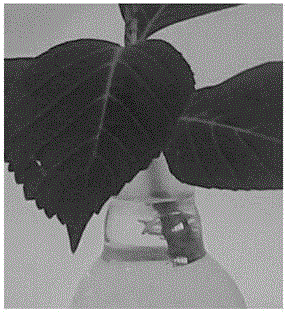Inducing method for water roots of plants
A water rooting and plant growth regulator technology, applied in the field of plant cultivation, can solve the problems of abnormal growth, expensive flowers, short viewing period, etc., and achieve the effect of prolonging the viewing period, convenient management and prolonging the viewing time
- Summary
- Abstract
- Description
- Claims
- Application Information
AI Technical Summary
Problems solved by technology
Method used
Image
Examples
Embodiment
[0038] Embodiment: the flower branch of hydrangea is induced rooting
[0039] The rooting method of the present invention is adopted to induce the rooting of hydrangea flowers.
[0040] Hydrangea, also known as hydrangea, is a plant of the genus Hydrangea in the saxifrage family. The leaves are large, opposite, with rough serrations on the edges, the branchlets are thick, with obvious lenticels, and the flowers are large and variable in color, white at first, and then turn blue or pink. Moisture-resistant, not cold-resistant, likes warmth and humidity, less pests and diseases.
[0041] Rooting hydrangea shoots involves the following steps:
[0042] 1. Select the hydrangea plant that grows vigorously and the flower buds differentiate or appear small flower buds, cut it off, the incision will be smooth, and cut the length of 10-50cm (the person who arranges the flowers can select the length according to needs, in this embodiment, respectively Choose 10, 30, 50cm for cultivati...
Embodiment 2
[0059] Embodiment 2: the floral branch of Chinese rose induces rooting
[0060] The rooting method of the present invention is adopted to induce the rooting of rose branches.
[0061] Chinese rose is a plant of the genus Rosa in the family Rosaceae. Rose is an upright shrub with thick, cylindrical branches and short thick hooked prickles. The leaflets are broadly ovate or ovate-oblong in shape, the base of the leaflet is round or broadly wedge-shaped, the edge of the leaflet is sharply serrated, and both sides are nearly glabrous. The top of the rose leaves are dark green with luster, and the bottom is lighter than the top. The natural flowering period of rose is from August of the current year to April of the following year. The flowers are large, unfold from the inside to the outside, and have a strong aroma. They are widely used in horticultural cultivation and cut flowers.
[0062] The rooting of Chinese rose branches includes the following steps:
[0063] 1. Select a ...
Embodiment 3
[0078] Embodiment 3: rose branch induces rooting
[0079] Rooting induction is carried out to flower branches of roses by adopting the flower arrangement method of the present invention for root induction.
[0080] Rose is a plant of the genus Rosa in the family Rosaceae. Erect shrubs, clustered, with stout stems, branchlets densely tomentose, with needles and glandular hairs, prickles covered with tomentose. Flowers solitary in leaf axils, or in clusters, with glandular hairs on margins of bracts, covered with tomentose. Rose is an important ornamental plant with high economic value.
[0081] Rooting rose branches involves the following steps:
[0082] 1. Select a plant that grows robustly and has differentiated flower buds, and cut it off, with a smooth cut, and a cut length of 10-50cm (it can be cut to a certain length according to needs).
[0083] Remove part of the leaves and leave 2-4 leaves.
[0084] 2. Before inducing rooting, use fungicide 50% chlorothalonil wett...
PUM
 Login to View More
Login to View More Abstract
Description
Claims
Application Information
 Login to View More
Login to View More - R&D
- Intellectual Property
- Life Sciences
- Materials
- Tech Scout
- Unparalleled Data Quality
- Higher Quality Content
- 60% Fewer Hallucinations
Browse by: Latest US Patents, China's latest patents, Technical Efficacy Thesaurus, Application Domain, Technology Topic, Popular Technical Reports.
© 2025 PatSnap. All rights reserved.Legal|Privacy policy|Modern Slavery Act Transparency Statement|Sitemap|About US| Contact US: help@patsnap.com



